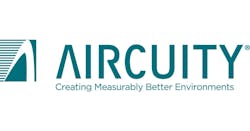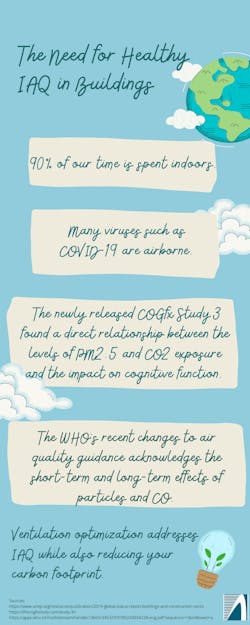New Research Draws Aircuity Call for ‘Ventilation Optimization’
PRESS RELEASE
NEWTON, MA - October 21, 2021 – Aircuity, the leader in creating healthy and sustainable buildings, today marked National Indoor Air Quality Month by recognizing the increased need for “ventilation optimization” in commercial buildings. This strategy creates healthier IAQ and reduces carbon emissions, enabling buildings to meet goals and standards for both as they emerge on the national, city and corporate levels..
Ventilation Optimization Reduces IAQ-Associated Health Risks
Ventilation optimization strategies support a recent announcement from the World Health Organization (WHO) that provided guidelines for lower thresholds for several IAQ parameters including particulate matter which has a direct association with cardiovascular and respiratory health risks.
Additionally, Aircuity’s ventilation optimization strategy supports the recently released COGfx Study 3 results which conclude that there is a direct relationship between the level of PM 2.5. and CO2 exposure and cognitive function. For every decrease in the levels of exposure though ventilation and filtration, these results indicate, cognitive function will increase in equal measure.
“This National Indoor Air Quality Month, we encourage building owners and operators to recognize that you can’t manage what you don’t measure and consider a healthy ventilation strategy of continually measuring and managing IAQ to science-based parameters,” said Dan Diehl, CEO of Aircuity. “With the WHO’s recent Air Quality Guidance, the COGfx Studies confirming IAQ’s influence on employee productively gains and COVID-19 driving awareness of IAQ, healthy buildings have now become critical to not only protecting employee’s health and wellbeing, but also as a permanent driver of business and mission success.”
Ventilation Optimization Reduces Carbon Emissions
This year’s National IAQ Month comes at a time when commercial property owners and developers are also bracing for more stringent regulations targeting inefficient buildings. New requirements now coming to the local and national levels will impose fines and other penalties for buildings that fail to reduce carbon emissions. Additionally, corporations and higher education institutions are also implementing new or enhanced carbon reduction and net zero carbon goals.
“The good news is that building owners and operators do not have to choose between healthy and sustainable,” Diehl stated. “Optimizing ventilation using Aircuity provides healthier air based on real-time conditions and can reduce HVAC energy use by 40-60% in research spaces and 15-30% in other areas, which reduces baseline energy requirements when targeting net zero carbon building operations.”
Aircuity has more than 20 years of experience and nearly 1,000 installations that are improving IAQ through accurate ventilation measurement and control in a variety of markets including Life Sciences, Higher Education K-12 Schools and Commercial Office. To learn more visit: www.aircuity.com.
ABOUT AIRCUITY
Aircuity is the 20-year leader in reducing carbon emissions and creating healthier indoor environments. Commercial, institutional and lab building owners can protect occupants, improve employee productivity and wellness, lower operating costs, and verifiably reduce energy use by as much as 60 percent. Headquartered in Newton, MA, Aircuity’s solutions have benefited organizations such as Google, Amazon, SUNY, Eli Lilly, Durst Organization, the University of Pennsylvania, and the University of California-Irvine. For additional information on the company and its solutions, please visit: www.aircuity.com.

